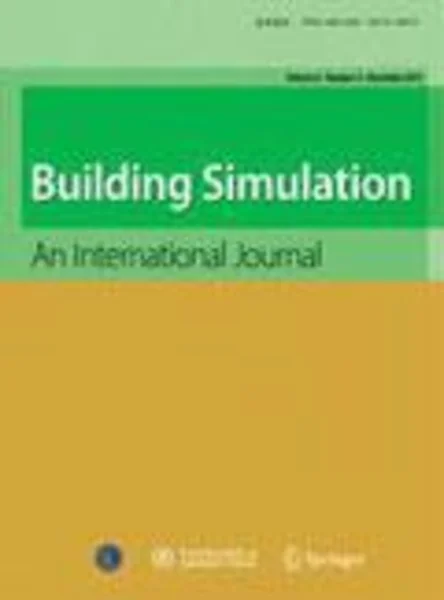-
computational simulations and optimization of flow and temperature distributions in a large-scale power plant building
جزئیات بیشتر مقاله- تاریخ ارائه: 1392/07/24
- تاریخ انتشار در تی پی بین: 1392/07/24
- تعداد بازدید: 916
- تعداد پرسش و پاسخ ها: 0
- شماره تماس دبیرخانه رویداد: -
for reduced carbon dioxide and pollutant emission, it is often as effective, if not more, to minimize energy use on the consumption side, as to maximize the efficiency on the power supply side. in this study, we seek to fully characterize and optimize the heating, ventilation, and air conditioning (hvac) electrical energy use in a large-scale structure: a power-plant building that houses boilers, turbines and other operating equipment. we use a fully three-dimensional computational fluid dynamics (cfd) model of this building, measuring 80 m in width, 120 m in length and 60 m in height, replicating the complex internal and external geometries, in order to simulate the flow and temperature distributions under a wide range of ambient and hvac operating conditions. the flow patterns and temperature distributions in this building structure are computationally simulated in detail, wherein the computed temperatures are validated through spot measurements. the detailed understanding of the flow patterns and temperature distributions then allows for optimization of the hvac configuration. identification of the problematic flow patterns and temperature mis-distributions, leads to some corrective measures, for optimization of the temperature distributions. the basic principles of fluid mechanics and heat transfer, applied in conjunction with cfd simulation results, can result in substantial improvements under both hot- and cold-weather conditions, in most cases with relatively simple, implementable modifications.
مقالات جدیدترین رویدادها
-
استفاده از تحلیل اهمیت-عملکرد در ارائه الگوی مدیریت خلاقیت سازمانی و ارائه راهکار جهت بهبود
-
بررسی تاثیر ارزش وجوه نقد مازاد بر ساختار سرمایه شرکت های پذیرفته شده در بورس اوراق بهادار تهران
-
بررسی تأثیر سطح افشای ریسک بر قرارداد بدهی شرکت های پذیرفته شده در بورس اوراق بهادار تهران
-
بررسی تأثیر رتبه بندی اعتباری مبتنی بر مدل امتیاز بازار نوظهور بر نقد شوندگی سهام با تأکید بر خصوصی سازی شرکت ها
-
تأثیر آمیخته بازاریابی پوشاک ایرانی بر تصویر ذهنی مشتری پوشاک ایرانی (هاکوپیان)
-
بررسی پارامترهای موثر بر مقاومت برشی و مکانیسم خرابی ستون های کوتاه بتن آرمه مستطیلی با استفاده از مدل المان محدود غیر خطی
-
بررسی میزان تأثیر پارامترهای لرزهای در رفتار دینامیکی دیوارهای خاکی میخکوبی شده
-
ارزیابی مقاومت فشاری بتن خودتراکم حاوی مواد پودری مختلف از طریق روش امواج اولتراسونیک
-
نقش اماکن گردشگری در توسعه کارآفرینی شهرها مخصوصا شهرستان ارومیه
-
activation of prosurvival signaling pathways during the memory phase of volatile anesthetic preconditioning in human myocardium: a pilot study
مقالات جدیدترین ژورنال ها
-
مدیریت و بررسی افسردگی دانش آموزان دختر مقطع متوسطه دوم در دروان کرونا در شهرستان دزفول
-
مدیریت و بررسی خرد سیاسی در اندیشه ی فردوسی در ادب ایران
-
واکاوی و مدیریت توصیفی قلمدان(جاکلیدی)ضریح در موزه آستان قدس رضوی
-
بررسی تاثیر خلاقیت، دانش و انگیزه کارکنان بر پیشنهادات نوآورانه کارکنان ( مورد مطالعه: هتل های 3 و 4 ستاره استان کرمان)
-
بررسی تاثیر کیفیت سیستم های اطلاعاتی بر تصمیم گیری موفق در شرکتهای تولیدی استان اصفهان (مورد مطالعه: مدیران شرکتهای تولیدی استان اصفهان)
-
بازشناسی تطبیقی ادبیات غنایی بر قالی سنگشکو با تاکید بر نگاره های مصور خمسه نظامی در دورۀ صفوی (مطالعه موردی: دیدار لیلی و مجنون و آبتنی شیرین)
-
بررسی تاثیر عوامل روانشناختی بر قصد خرید و تعهد مشتری (مطالعه موردی: مشتریان پوشاک هاکوپیان مشهد)
-
isolation, purification and identification of β-carotene from azolla pinnata r. br. as a new carotenoid wealthy source
-
seismic loss assessment: the case study of the power distribution network in arak city, iran
-
evaluation of aesthetic, functional, and environmental effects on the design of urban open spaces: a case study of istanbul şişhane park, turkey




سوال خود را در مورد این مقاله مطرح نمایید :